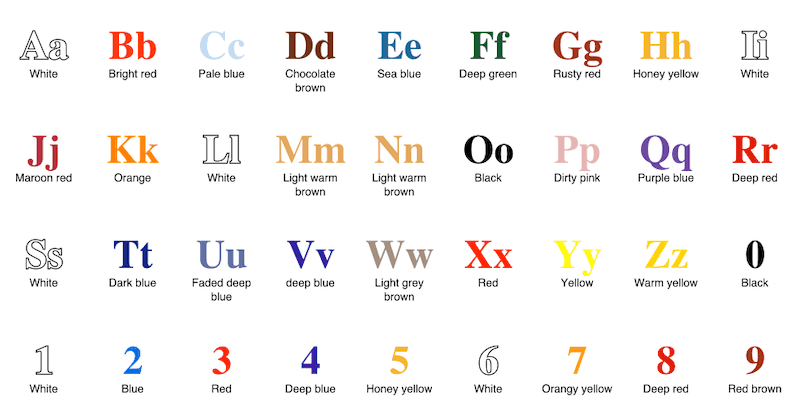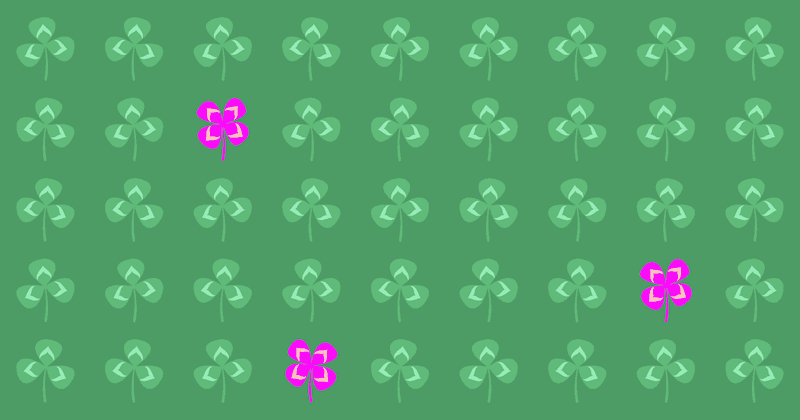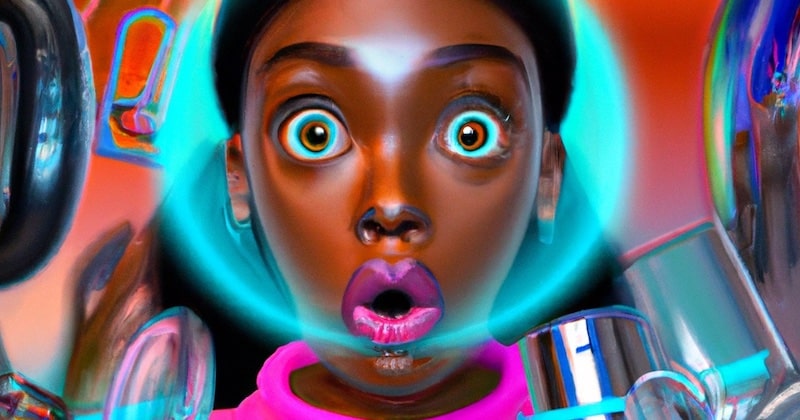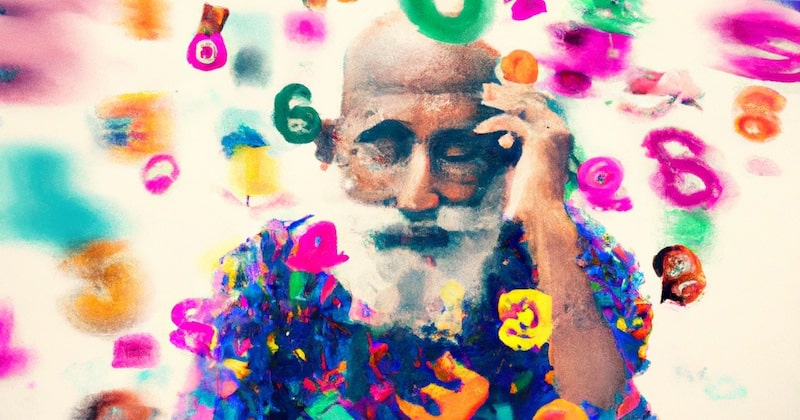My Synesthesia Story (Colored Letters & Numbers)
17 Jan 2023

Table of contents
For as long as I can remember I have associated a particular color to each letter of the alphabet, including single-digit numbers.
Days of the week have particular colors for me too.
When I discovered that none of my friends experienced anything like this, my first thought was I might be a bit crazy!
But eventually, I discovered I was not alone with these experiences...
My Synesthesia Story
It all began one day in primary school when my class was doing a coloring-in exercise.
The teacher gave us a piece of paper with the letters of the alphabet in an outlined font. Our task was to color them — an easy task you might think, but for me, it was quite distressing.
In the middle of our desks, we had tins of colored pencils and the selection of colors was poor.
This was where my problems began.
I had a very strong sense of which color each letter had to be, and so naturally, I chose colored pencils that matched.
This worked well for basic colors like red, yellow, or blue but things became difficult when I wanted an odd color like faded deep blue or dirty pink.
I tried blending colors to get the right hue but I could only do so much with the limited colors available on my desk. I decided it might be easier to find different colored pencils from some of the other desks.
As I walked around the room I noticed to my horror that the other kids were coloring their letters in completely the wrong colors!
I was quite upset.
To me, the colors of the alphabet were such a strong sensation that I could never imagine them being any other hue.
I immediately began telling the other kids that their drawings were wrong.
I explained what color each letter should be and I was quite forceful about it. Some of the kids followed my suggestions but a few stood up to me and as a result of these disagreements, the class was disrupted.
The teacher stepped in to resolve the dispute and naturally, she explained that there was no right or wrong color for each letter.
I was so confused.
My teacher had never heard of synesthesia and she probably thought I was just being difficult. I went back to my desk disillusioned and continued to color my letters in the right colors as best I could, all the while trying to understand the situation.
Because of my bad experience in the classroom, from that point on I stopped telling other people about my alphabet colors.
I thought that something was wrong with me and I didn't want other people to know.
I did share my experiences with some close friends and family but I always got the same response: Woah... What?
It wasn't until years later that I finally came to understand my condition.
When I got access to the internet, one of the first things I researched was colored alphabets. To my surprise, I discovered many people had similar experiences and the condition was well documented.
It was called synesthesia.
What is Synesthesia?
Synesthesia can be explained as a kind of mixture or cross-wiring of the senses.
It's a condition in which one type of stimulation evokes the sensation of another, as when the hearing of a sound produces the visualization of a color. This secondary stimulus does not replace the primary one but is an additionally perceived input. In this regard, synesthetes can quite often see more when they look out on the world.
There are many forms of synesthesia and no two people who have this condition are the same.
The most common experiences reported by synesthetes are associating colors to musical notes or seeing letters and numbers as particular hues as I do, this is called grapheme-color synesthesia.
Interestingly, when comparing people that suffer similar forms of synesthesia, the details rarely match. One person's letter 'A' may be red and another person can see it as green.
There does not appear to be a common basis as to which color a sufferer will see but once the association is in place it's there for life. Synesthetes tested decade's later consistently report the same results.
The following video is fascinating, it offers the first explanation I have found of how synesthesia could work within the brain.
3 clues to understanding your brain: TED Talk by Vilayanur Ramachandran
A summary of Ramachandran's explanation of synesthesia
Babies are born with a highly interconnected brain, then as they grow older the cross-wiring is trimmed down naturally.
In some families, there must be a genetic condition that causes this trimming to be less effective. The result is synesthetes (people with synesthesia) have areas of cross-wiring still intact.
This causes normally separate areas of the brain to remain linked. For me, these areas are colors, numerals, letters, and some sounds.
Vilayanur argues that this cross-wiring of the brain leads to a greater propensity for metaphorical thinking and creativity. The condition is eight times more common in creative people like artists, musicians, and novelists.
I'm creative, and creativity runs through my family, particularly on my Dad's side (he was a full-time artist and art teacher). Maybe there is a science behind creativity after all?
If you find this talk fascinating then I highly recommend Vilayanur's book Phantoms in the Brain: Probing the Mysteries of the Human Mind.
I first read his book several years ago but it wasn't until his talk on TED that I learned of his work regarding Synesthesia.
Interesting Synesthesia Observations
I have noticed a few curious things about my particular flavor of synesthesia that are worth pointing out.
There are some relationships between the shapes, sounds, and colors.
My colored alphabet

I find that some letters don't have a strong color but I see those as either dark or light, so they are listed as black or white.
Some of these colorless letters seem to be related by shape:
- Ii, Ll, and 1 (all vertical lines) appear as white.
- Oo and 0 (all circles) appear as black.
And some seem related by sound:
- Ss and 6 both have the same 'Sss' sound and they appear as white (similar to white noise).
- Cc has a similar soft 'Sss' sound and it's a very light color.
And I only have one green letter, 'Ff', and none of my favorite color, turquoise :(
My colored days of the week
| Day | Color |
|---|---|
| Monday | Yellow |
| Tuesday | Blue |
| Wednesday | Yellow |
| Thursday | Blue |
| Friday | Red |
| Saturday | Fawny-brown |
| Sunday | Fawny-brown |
2, Tt, Tuesday, and Thursday all have a 't/too' sound and they appear blue.
Unfortunately, I can't see any other associations wuth the days that make any sense.
Will My Kids Become Synesthetes?
This is a really interesting question!
If genetics has some part to play with the cause of synesthesia then it's highly likely that my kids will develop some form of the condition.
My eldest daughter has already indicated that she has colors for some of her letters and she is also a very creative kid.
My youngest son could be more interesting because his mother is also a synesthete. She sees words as colors similar to how I see colored days of the week.
I will have to report back on this when I have more data to share!
But for now, I hope I have shed some light on this interesting condition =)




 Web design
Web design
 Architecture
Architecture
 Life drawing
Life drawing
 Art gallery
Art gallery
 Synesthesia
Synesthesia
 Comics
Comics